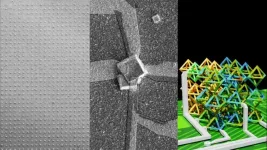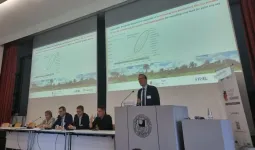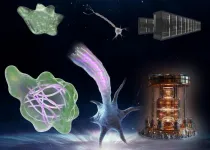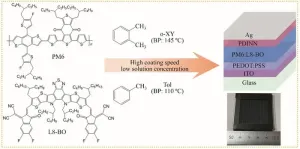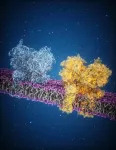(Press-News.org) Researchers at Columbia Engineering have for the first time used DNA to help create 3D electronically operational devices with nanometer-size features.
"Going from 2D to 3D can dramatically increase the density and computing power of electronics," said corresponding author Oleg Gang, professor of chemical engineering and of applied physics and materials science at Columbia Engineering and leader of the Center for Functional Nanomaterials' Soft and Bio Nanomaterials Group at Brookhaven National Laboratory.
The new manufacturing technique could also contribute to the ongoing effort to develop AI systems that are directly inspired by natural intelligence.
"3D electronic architectures that imitate the natural 3D structure of the brain may prove enormously more effective at running brain-mimicking artificial intelligence systems than existing 2D architectures," Gang said. The researchers detailed their findings March 28 in the journal Science Advances.
From etching to folding
Conventional electronics rely on flat circuitry. To help microchips grow more powerful, researchers worldwide are experimenting with approaches to building them in three dimensions.
However, current electronics manufacturing techniques are top-down in nature — a piece of material is gradually eroded, for example, by an electron beam, until the desired structure is achieved, like sculpting a block of stone. These methods have encountered problems fabricating 3D devices when it comes to creating complex structures and doing so in a cost-effective manner. For instance, they face challenges in assembling multiple layers of circuitry that stack up properly. "Over the course of hundreds of steps during production, errors accumulate that are prohibitive from the point of view of performance and cost," Gang said.
A conceptually different way to build a 3D system is from the bottom up, where many components self-assemble into complex structures. Now Columbia Engineering researchers have developed a new biologically inspired bottom-up way for 3D electronics to build themselves. The key behind the new technique is the way in which strands of DNA can fold themselves into shapes — so-called origami. These building blocks, called frames, are then used to assemble large-scale 3D structures, called frameworks, with nanoscale precision.
DNA is made of strings of four different kinds of molecules, known by the letters A, T, C and G. These stick to each other in highly specific ways — A to T, and C to G. By designing multiple molecules with the right sequences, researchers can get long DNA strands to fold themselves into 2D or 3D shapes. Snippets of DNA stapled onto these strands then hold the folded designs in place.
Building the prototype
In the new study, the study’s first author Aaron Michelson, a staff scientist at Brookhaven National Laboratory's Center for Functional Nanomaterials, who was previously a PhD student at Gang’s group, along with Gang and their colleagues, deposited arrays of gold squares on a surface, onto which they could attach short pieces of DNA. These molecules served as anchors to which they could fasten eight-sided diamond-like octahedral DNA frames that self-assemble into 3D frameworks at these specific surface locations.
"These gold arrays with anchored DNA strands promote the growth of 3D DNA scaffolds on designated areas in desired patterns and orientations, which allows us to establish and integrate this DNA onto an electronic wafer," Gang said.
The researchers, in collaboration with Professor Vald Pribiag’s group at the University of Minnesota, next coated these DNA scaffolds with silicon oxide, laced them with the semiconductor tin oxide, and connected electrodes to each structure. The result — light sensors that respond electrically when illuminated.
"We've demonstrated that not only can we create 3D structures from DNA, but integrate them into microchips as part of the workflow of how electronic devices are fabricated," Gang said. "We can place thousands of these structures at specific sites on silicon wafers in a scalable way. This demonstrates that we can drastically change how we fabricate complex 3D electronic devices."
"For a long time, we have worked on what phenomena might help build a self-assembling electronic device," Gang said. "It's exciting to now actually demonstrate these futuristic ideas, to actually make an operational device using these bottom-up fabrication processes."
In the future, Gang and his colleagues would like to use their new method to create more complex electronic devices using more than one material. "The next dream is creating 3D circuitry," he said.
END
DNA helps electronics to leave flatland
These miniature scaffolds for 3D circuits are designed to assemble themselves
2025-03-28
ELSE PRESS RELEASES FROM THIS DATE:
Studying cardiac cells in space to repair heart damage on Earth
2025-03-28
KENNEDY SPACE CENTER (FL), March 28, 2025 – Heart disease remains the leading cause of death in the United States, accounting for one in five deaths. The inability of damaged heart muscle tissue to regenerate makes heart disease difficult to treat, and end-stage heart failure patients have no choice but to join a long list of people waiting for a heart transplant. Researchers from Emory University are working to provide another option for such patients. To do this, the team took their research to a laboratory unlike any on Earth—the International Space Station (ISSInternational Space Station).
Chunhui ...
Studies evaluate the health effects of bioactive compounds obtained from plants
2025-03-28
Fruits and plant extracts contain bioactive compounds that can help treat or prevent diseases. To characterize and understand their mechanism of action, researchers from universities and research institutions in Brazil and Germany have conducted independent but complementary studies.
Some of the results were presented at a lecture session on the future of food and nutrition research on March 25th during FAPESP Week Germany at the Free University of Berlin.
According to Ulrich Dobrindt, a professor at the University of Munich in Germany, medicinal plants contain different types of phytochemicals (natural ...
Howard University physicist revisits the computational limits of life and Schrödinger’s essential question in the era of quantum computing
2025-03-28
WASHINGTON, DC – (March 28, 2025) More than 80 years ago, Erwin Schrödinger, a theoretical physicist steeped in the philosophy of Schopenhauer and the Upanishads, delivered a series of public lectures at Trinity College, Dublin, which eventually came to be published in 1944 under the title What is Life?
Now, in the 2025 International Year of Quantum Science and Technology, Philip Kurian, a theoretical physicist and founding director of the Quantum Biology Laboratory (QBL) at Howard University in Washington, D.C., has used the laws of quantum mechanics, which Schrödinger postulated, and the QBL’s discovery of cytoskeletal ...
Navigating a US bioscience career despite anticipated cuts in funding for biomedicine
2025-03-28
Many young and midcareer scientists in the U.S. are understandably anxious about potential cuts to government funding and the rise of junk science. Although your future in biomedicine may not be what you originally planned, it might actually become more interesting and filled with new possibilities and opportunities for innovation. Don’t think of this time to hunker down and disappear. Do the opposite with the understanding that you are more powerful and brilliant than you may realize.
In your coverage, please use this URL to provide access to ...
How the failure of two dams amplified the Derna Flood tragedy
2025-03-28
A new study reveals that the devastating 2023 flood in Derna, Libya, was not merely the result of extreme rainfall but was drastically intensified by a major design shortcoming and its resulting collapse of two embankment dams. Through advanced hydrological modeling and satellite data analysis, researchers found that while Storm Daniel brought heavy rainfall, the catastrophe stemmed from dam failures and flawed risk assessment and communication—amplifying the destruction nearly twentyfold. The findings highlight the urgent need for improved flood mitigation strategies, especially in dryland regions where high uncertainty ...
Oral contraceptives and smoking impact steroid hormone levels in healthy adults
2025-03-28
Steroid hormone levels in healthy adults are influenced by oral contraceptives and smoking, as well as other lifestyle choices and factors such as biological sex and age, according to new research that has just been published in leading international journal Science Advances.
The objective of the research was to expand knowledge and understanding of steroid hormone levels, including corticoids and sex hormones, in healthy women and men over a broad age range. This is the first study to analyse such a large number of hormones in nearly 1,000 healthy people, filling a ...
C-Path’s predictive safety testing consortium advances a transformative test to detect drug induced liver injury
2025-03-28
TUCSON, Ariz., March 27, 2025 – Researchers from Critical Path Institute’s® (C-Path) Predictive Safety Testing Consortium have proposed glutamate dehydrogenase (GLDH) as a more liver-specific biomarker for detecting liver injury, supporting clearer decision-making. Currently, alanine aminotransferase and aspartate aminotransferase (ALT and AST) are considered the “gold standard” biomarkers in clinical practice and drug development. However, these biomarkers are not specific to the liver and can reflect changes in other tissues, which may lead to unclear diagnoses, particularly in individuals with muscle conditions ...
Green solvent innovation: high-speed doctor-blading boosts organic solar cell efficiency
2025-03-28
In a recent advancement, researchers have developed a high-speed doctor-blading technique that enhances the efficiency of organic solar cells (OSCs) while using eco-friendly, non-halogenated solvents. This innovative method not only addresses the environmental and scalability challenges of traditional solvents, such as chloroform, but also achieves impressive power conversion efficiencies (PCEs) of 18.20% and 17.36% with green solvents like o-xylene and toluene, respectively. With a module efficiency of 16.07%, this breakthrough sets the stage for more sustainable, ...
C-Path announces successful conclusion of the ECOA: getting better together initiative
2025-03-28
TUCSON, Ariz., March 26, 2025 – Critical Path Institute® (C-Path)Patient-Reported Outcome (PRO) Consortium and Electronic Clinical Outcome Assessment (eCOA) Consortium are pleased to announce the successful conclusion of the eCOA: Getting Better Together Initiative. This initiative, driven by a shared commitment to advancing patient-focused drug development, has culminated in meaningful, lasting changes that will benefit all stakeholders across the eCOA ecosystem.
Beginning in 2019, this C-Path-led collaborative, pre-competitive initiative brought ...
Brain channels ‘stopped in time’ reveal chemical flow that enables learning and thinking
2025-03-28
FOR IMMEDIATE RELEASE
In an effort to understand how brain cells exchange chemical messages, scientists say they have successfully used a highly specialized microscope to capture more precise details of how one of the most common signaling molecules, glutamate, opens a channel and allows a flood of charged particles to enter. The finding, which resulted from a study led by Johns Hopkins Medicine researchers, could advance the development of new drugs that block or open such signaling channels to treat conditions as varied as epilepsy and some intellectual disorders.
A report on the experiments, funded by the National ...
LAST 30 PRESS RELEASES:
Science briefing: An update on GLP-1 drugs for obesity
Lower doses of immunotherapy for skin cancer give better results
Why didn’t the senior citizen cross the road? Slower crossings may help people with reduced mobility
ASH 2025: Study suggests that a virtual program focusing on diet and exercise can help reduce side effects of lymphoma treatment
A sound defense: Noisy pupae puff away potential predators
Azacitidine–venetoclax combination outperforms standard care in acute myeloid leukemia patients eligible for intensive chemotherapy
Adding epcoritamab to standard second-line therapy improves follicular lymphoma outcomes
New findings support a chemo-free approach for treating Ph+ ALL
Non-covalent btki pirtobrutinib shows promise as frontline therapy for CLL/SLL
University of Cincinnati experts present research at annual hematology event
ASH 2025: Antibody therapy eradicates traces of multiple myeloma in preliminary trial
ASH 2025: AI uncovers how DNA architecture failures trigger blood cancer
ASH 2025: New study shows that patients can safely receive stem cell transplants from mismatched, unrelated donors
Protective regimen allows successful stem cell transplant even without close genetic match between donor and recipient
Continuous and fixed-duration treatments result in similar outcomes for CLL
Measurable residual disease shows strong potential as an early indicator of survival in patients with acute myeloid leukemia
Chemotherapy and radiation are comparable as pre-transplant conditioning for patients with b-acute lymphoblastic leukemia who have no measurable residual disease
Roughly one-third of families with children being treated for leukemia struggle to pay living expenses
Quality improvement project results in increased screening and treatment for iron deficiency in pregnancy
IV iron improves survival, increases hemoglobin in hospitalized patients with iron-deficiency anemia and an acute infection
Black patients with acute myeloid leukemia are younger at diagnosis and experience poorer survival outcomes than White patients
Emergency departments fall short on delivering timely treatment for sickle cell pain
Study shows no clear evidence of harm from hydroxyurea use during pregnancy
Long-term outlook is positive for most after hematopoietic cell transplant for sickle cell disease
Study offers real-world data on commercial implementation of gene therapies for sickle cell disease and beta thalassemia
Early results suggest exa-cel gene therapy works well in children
NTIDE: Disability employment holds steady after data hiatus
Social lives of viruses affect antiviral resistance
Dose of psilocybin, dash of rabies point to treatment for depression
Helping health care providers navigate social, political, and legal barriers to patient care
[Press-News.org] DNA helps electronics to leave flatlandThese miniature scaffolds for 3D circuits are designed to assemble themselves
